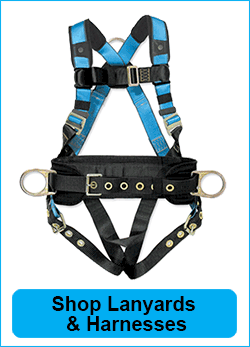
The oil and gas industry is critical to the economy, and like many industries, it has been hit hard by the coronavirus pandemic. But despite the slump, the safety of employees working on oil rigs and refineries is still a leading OSHA priority. Downtime or not, the oil industry remains a dangerous place for workers exposed to chemical, physical, and biological hazards. In fact, downtime might be the perfect time to reassess your current safety practices and ensure your safety equipment is top of the line.
A Note on OSHA Fall Protection Standards and Guidelines for Oil & Gas
Under OSHA’s General Duty Clause, employers in the oil and gas industry must provide employees with a safe working environment—including any fall hazards that may risk injury. But the standards can be hard to pin down; since oil extraction involves a litany of processes (exploration, drilling, storage, refining, and servicing) there’s isn’t a set standard specific to the industry. Instead, fall protection guidelines are covered through OSHA’s standards for general industry, construction, and marine operations. These regulations require that fall protection be provided at elevations of six feet in the construction industry, four feet in general industry, and eight feet in offshore operations—and it’s up to you to interpret which standards applies to your worksite.
Fall Protection Equipment for Oil Rig Workers

Likewise, many offshore oil rig work platforms rise in excess of 100 feet above the surface of the ocean. Despite some impressive engineering, in periods of high wind, these rigs can be prone to swaying, adding an additional hazard to the mix. No matter on land or sea, the ladders, riser stacks, machinery, derricks, and the process of rigging up and rigging down put your workers at risk. Fortunately, today’s fall protection equipment systems offer user-friendly and adaptable systems that are easy to incorporate, helping the oil industry maintain OSHA fall protection compliance at all times.
Fall protection harnesses & lanyards
Oil extraction workers spend long hours in some of the most challenging work conditions on the planet. These unique conditions often make using guard rails or other passive fall protection infeasible. Fall protection harnesses are often the best option, and given the nature of the work, ideal safety harnesses feature durable, adjustable, waterproof, and stain-resistant straps.
When considering your options, check for the following: flexible front and back anchor points including front strap loops and D-rings that are easy to fasten, along with easy access buckles and flexible chest straps so your fall protection harnesses can be adjusted for a perfect fit. Highly visible seams and fall indicators should be integrated into the harness, showing whether it has been in a fall and/or if it is no longer suitable for use. Along with their harness, workers will also need a self-retracting lifeline or lanyard attached to an anchor point, along with a secondary lifeline attached to a different anchor point for added safety.
A Safety Gate = Access Protection
Outside of falls, there are eight other major hazards that need addressing in the oil and gas industry. These include:
- vehicle collisions
- struck-by/caught-in/caught-between accidents
- explosions and fires
- chemical exposure
- confined spaces
- machine hazards
- ergonomic hazards
- high pressure lines and equipment
The installation of a safety gate can help tremendously, not only by providing effective fall protection, but also by limiting access to only authorized personal when any of these risks are present. Self-closing metal swing gates are particularly useful as they remove the risk of gates being left open and unattended. There are a variety of metal swing gates on the market to accommodate multiple sites and sizes, from ladders and walkways to mezzanines and loading docks. When metal swing gates aren’t appropriate due to your work area’s shape and size, or other factors, a rolling safety gate maybe be a more viable option.
Enhancing OSHA Fall Protection
Whether you focus on offshore or onshore production, ensuring your employees are safe requires commitment to maintaining safety at all times. OSHA fall protection compliance requires a comprehensive strategy, which includes the proper combination of fall protection equipment, execution, and training. Thorough training is required for all employees to understand the risks they face daily, what fall protection is appropriate, how each fall protection system works, and the need to perform routine checks on the equipment before each use.
In addition, each team leader or supervisor should be certified as a competent person to ensure worker safety. According to OSHA, a competent person is “one who is capable of identifying existing and predictable hazards in the surroundings or working conditions which are unsanitary, hazardous, or dangerous to employees, and who has authorization to take prompt corrective measures to eliminate them.”
Oil extraction workers are some of the bravest employees to be found and complacency is never an option. Fortunately, with the right equipment and the proper training, many oil and gas risks can be avoided. If you’d like to learn more about your options—from fall protection harnesses and lanyards to anchor points, metal swing gates, and guardrails, give us call. At Fabenco, we’ve been keeping workers safe and companies productive for over forty years. Contact us today.




